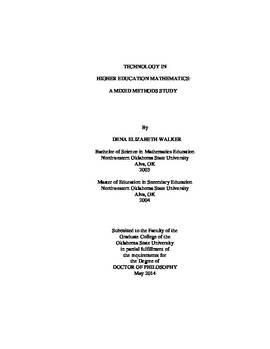| dc.contributor.advisor | Lamphere-Jordan, Patricia | |
| dc.contributor.author | Walker, Dena Elizabeth | |
| dc.date.accessioned | 2015-06-17T20:08:24Z | |
| dc.date.available | 2015-06-17T20:08:24Z | |
| dc.date.issued | 2014-05 | |
| dc.identifier.uri | https://hdl.handle.net/11244/15164 | |
| dc.description.abstract | The integration of technology has become a high priority at various levels of education, including higher education. This study focused on discovering and describing the technology being used in higher education mathematics content courses by faculty members at colleges and universities. The research questions focused on what technology was being used by higher education mathematics faculty, how it was being used, what factors would encourage the incorporation of technology, the description of an adopter of technology, who is most likely to use technology to engage students in learning, and challenges that must be overcome to implement technology. The study uses an explanatory sequential mixed methods design which allowed for gathering qualitative data through semi-structured interviews and a vignette to support the quantitative data, which was gathered from a general technology survey administered electronically. The participants included 68 faculty members from research universities, regional public and private universities, and community colleges in a Midwestern state. Results from the study found that technology used by faculty included computers, projector systems, calculators, word processing software, learning management systems, e-mail communication, and the Internet. Technology was found to be predominately used for classroom instruction as a visual aid to present multiple forms of mathematical representations. Factors that could influence the integration of technology into mathematics content courses include the need for a technology resource bank that has appropriate and high-quality tasks that correspond to content and the need for additional time to investigate and implement new technologies. The description of an adopter of technology that evolved during the study was not adequate, but the analysis did show that the attitudes and beliefs of faculty toward technology influenced technology-use preferences. Future research is needed to identify a complete description of an adopter of technology. The study also reinforced the idea that technology-rich classrooms offer an avenue to engage students in learning mathematics. Lastly, the study highlighted challenges that faculty encounter when integrating technology including demands from administration, time for exploration, the need for additional training opportunities, and the lack of technical support. | |
| dc.format | application/pdf | |
| dc.language | en_US | |
| dc.rights | Copyright is held by the author who has granted the Oklahoma State University Library the non-exclusive right to share this material in its institutional repository. Contact Digital Library Services at lib-dls@okstate.edu or 405-744-9161 for the permission policy on the use, reproduction or distribution of this material. | |
| dc.title | Technology in higher education mathematics: A mixed methods study | |
| dc.contributor.committeeMember | Redmond-Sanogo, Adrienne | |
| dc.contributor.committeeMember | Nowell, Shanedra | |
| dc.contributor.committeeMember | Tapps, Tyler | |
| osu.filename | Walker_okstate_0664D_13231.pdf | |
| osu.accesstype | Open Access | |
| dc.type.genre | Dissertation | |
| dc.type.material | Text | |
| thesis.degree.discipline | Professional Education Studies | |
| thesis.degree.grantor | Oklahoma State University | |
